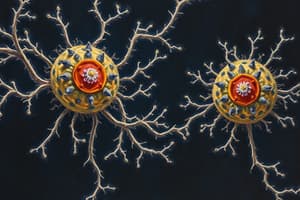Podcast
Questions and Answers
Eubacteria that lack cell walls and do not synthesize the precursors of peptidoglycan are called
Eubacteria that lack cell walls and do not synthesize the precursors of peptidoglycan are called
- Gram-negative bacteria
- Mycoplasmas (correct)
- Viruses
- Bacilli
- Serovar
Most microorganisms pathogenic for humans grow best in the laboratory when cultures are incubated at
Most microorganisms pathogenic for humans grow best in the laboratory when cultures are incubated at
- 15-20°C
- 30-37°C (correct)
- 20-30°C
- 50-55°C
- 38-50°C
Which of the following specimens does not usually contain anaerobes?
Which of the following specimens does not usually contain anaerobes?
- Cerebrospinal fluid from a patient with meningitis
- Throat swab from a patient with a sore throat (correct)
- Expectorated sputum from a patient with community-acquired pneumonia
- Aspiration from an infected maxillary sinus
How many organisms must be present in a clean catch midstream urine sample to be considered indicative of an infection?
How many organisms must be present in a clean catch midstream urine sample to be considered indicative of an infection?
Which type of direct specimen involves collecting fluid from the lower respiratory tract?
Which type of direct specimen involves collecting fluid from the lower respiratory tract?
Which of the following represents a level of laboratory safety concerning biological hazards?
Which of the following represents a level of laboratory safety concerning biological hazards?
Which method is not typically used to diagnose infections in the genital tract?
Which method is not typically used to diagnose infections in the genital tract?
What is the primary use of charcoal in buffered charcoal yeast extract agar?
What is the primary use of charcoal in buffered charcoal yeast extract agar?
Which test is most readily used to confirm M. pneumoniae infection in the laboratory?
Which test is most readily used to confirm M. pneumoniae infection in the laboratory?
Which characteristic is essential in a nontreponemal serological test?
Which characteristic is essential in a nontreponemal serological test?
For which purpose is enzyme immunoassay (EIA) performed on genital tract specimens?
For which purpose is enzyme immunoassay (EIA) performed on genital tract specimens?
What is a definitive method for identifying an anaerobic bacterium?
What is a definitive method for identifying an anaerobic bacterium?
Which test differentiates M. catarrhalis from saprophytic neisseriae in respiratory samples?
Which test differentiates M. catarrhalis from saprophytic neisseriae in respiratory samples?
Which test is useful for monitoring antibiotic treatment of primary or secondary syphilis?
Which test is useful for monitoring antibiotic treatment of primary or secondary syphilis?
The microorganism that could use CO2 as a carbon source and inorganic chemical compounds as an energy and electron source is:
The microorganism that could use CO2 as a carbon source and inorganic chemical compounds as an energy and electron source is:
The compound that lacks the presence of phosphates in the structure of a bacterial Gram-positive cell wall is:
The compound that lacks the presence of phosphates in the structure of a bacterial Gram-positive cell wall is:
The microorganism that has no ability to synthesize a growth factor is:
The microorganism that has no ability to synthesize a growth factor is:
The swarming of Proteus bacteria is inhibited if the concentration of agar is:
The swarming of Proteus bacteria is inhibited if the concentration of agar is:
Nitrosomonas is:
Nitrosomonas is:
Which one of the following is most responsible for the nature of the lesion on the foot caused by Staphylococcus aureus?
Which one of the following is most responsible for the nature of the lesion on the foot caused by Staphylococcus aureus?
The blood culture was negative. What is the best explanation for this?
The blood culture was negative. What is the best explanation for this?
Which of the following is present in prokaryotes but not eukaryotes?
Which of the following is present in prokaryotes but not eukaryotes?
The nitrogen bases in DNA are bonded to the:
The nitrogen bases in DNA are bonded to the:
Which of the following mediums is selective for Salmonella?
Which of the following mediums is selective for Salmonella?
Which hypersensitivity reaction is predominantly involving IgE?
Which hypersensitivity reaction is predominantly involving IgE?
Cytotoxic T cells kill their targets via which mechanisms?
Cytotoxic T cells kill their targets via which mechanisms?
Pattern recognition molecules can distinguish:
Pattern recognition molecules can distinguish:
Which of the following inhibits DNA gyrase?
Which of the following inhibits DNA gyrase?
Which of the following antimicrobial drugs is synthetic?
Which of the following antimicrobial drugs is synthetic?
Which clinical situation would be appropriate for treatment with a narrow-spectrum antimicrobial drug?
Which clinical situation would be appropriate for treatment with a narrow-spectrum antimicrobial drug?
Which of the following is not a type of β-lactam antimicrobial?
Which of the following is not a type of β-lactam antimicrobial?
Which of the following resistance mechanisms describes the function of β-lactamase?
Which of the following resistance mechanisms describes the function of β-lactamase?
The etiology of the sore throat would have been best determined by:
The etiology of the sore throat would have been best determined by:
Virulence means:
Virulence means:
What laboratory test would be most likely to confirm the diagnosis of Lyme disease?
What laboratory test would be most likely to confirm the diagnosis of Lyme disease?
An F-pilus is essential for:
An F-pilus is essential for:
Which of the following statements about gene expression is false?
Which of the following statements about gene expression is false?
Which of the following is NOT characteristic of eukaryotic gene expression?
Which of the following is NOT characteristic of eukaryotic gene expression?
The presence of which of the following is NOT typically used to determine the etiology of a sore throat?
The presence of which of the following is NOT typically used to determine the etiology of a sore throat?
Which diagnostic method is NOT typically associated with Lyme disease?
Which diagnostic method is NOT typically associated with Lyme disease?
Which of these is a type of Anthrax?
Which of these is a type of Anthrax?
On which of these media can Salmonella grow?
On which of these media can Salmonella grow?
Salmonella can ferment which of the following?
Salmonella can ferment which of the following?
Which of the following are antigens found in Enterobacteriaceae?
Which of the following are antigens found in Enterobacteriaceae?
Which toxins are secreted by E. coli?
Which toxins are secreted by E. coli?
Which antigens does Klebsiella have?
Which antigens does Klebsiella have?
Lactobacillus ferments sugars to produce which of the following?
Lactobacillus ferments sugars to produce which of the following?
Which of the following antibiotics have an extended spectrum?
Which of the following antibiotics have an extended spectrum?
What patterns of disease outbreaks in communities exist?
What patterns of disease outbreaks in communities exist?
What is the indicator used in the phenylalanine deamination test?
What is the indicator used in the phenylalanine deamination test?
How is antibacterial susceptibility determined?
How is antibacterial susceptibility determined?
Which phenotypic trait is associated with a systemic fungal pathogen?
Which phenotypic trait is associated with a systemic fungal pathogen?
Which fungal pathogen causes Tinea corporis?
Which fungal pathogen causes Tinea corporis?
How saturated with oxygen is the hemoglobin in blood leaving the lungs?
How saturated with oxygen is the hemoglobin in blood leaving the lungs?
Which type of bacterial enzyme does not need water for reactions?
Which type of bacterial enzyme does not need water for reactions?
What is an important nutrient for bacterial teichoic acid?
What is an important nutrient for bacterial teichoic acid?
Which bacterial group cannot grow at temperatures below 55°C?
Which bacterial group cannot grow at temperatures below 55°C?
Which metabolic pathway is used by bacteria but not by eukaryotes?
Which metabolic pathway is used by bacteria but not by eukaryotes?
Which of the following are storage inclusions in bacteria?
Which of the following are storage inclusions in bacteria?
All of the following are true regarding penicillins EXCEPT
All of the following are true regarding penicillins EXCEPT
Which of the following antibiotics does NOT inhibit nucleic acid synthesis?
Which of the following antibiotics does NOT inhibit nucleic acid synthesis?
Which of the following antibiotics functions as a protein synthesis inhibitor?
Which of the following antibiotics functions as a protein synthesis inhibitor?
Flashcards are hidden until you start studying
Study Notes
Microbiology Examination Questions
- Competition Examination 2021-2022
- Questions 1-5: Multiple choice questions on various microbiology topics, including bacterial growth, metabolism, and identification.
Microbiology Topics
- Serology
- Using complement fixation, cell culture, direct fluorescent antibody testing, nucleic acid amplification methods, and enzyme immunoassays to diagnose infections.
- Lyme Disease
- Laboratory diagnosis of Lyme disease involves Borrelia burgdorferi immunoassay, immunoblot, and PCR of CSF.
- Spore Formation
- Stages of spore formation: vegetative cell, sporulation, and germination.
- F-pilus
- Essential for DNA transformation, chromosome transfer by conjugation, and plasmid transfer by conjugation.
- Gene Expression
- More than one RNA polymerase can transcribe a specific gene at a given time; translation begins at a site called a promoter.
- Eukaryotic Gene Expression
- Characteristics: 5' cap added to mRNA, poly A tail added to 3' end of mRNA, introns removed, and mRNA is often polycistronic.
Biology Exam
- Multiple Choice
- Prokaryotes lack spliceosomes; DNA is bonded to deoxyribose.
- Short Answer
- Compare conjugation, transformation, and transduction; differences between direct and indirect tests; selective mediums for Salmonella.
Additional Questions
- Microbial Activity
- Determining microbial activity level involves measuring factors such as growth rate, metabolism, and enzyme activity.
- Carbon Cycle
- Differences between carbon cycle in land and microorganisms: land-based carbon cycle involves decomposition, while microorganisms use carbon dioxide and release oxygen.
Q13-14
- Antimicrobial Drugs
- Inhibit DNA gyrase, such as Ciprofloxacin; sulfanilamide is a synthetic antimicrobial drug; narrow-spectrum antimicrobial drugs for specific infections.
- Antimicrobial Resistance
- Mechanisms: target mimicry, β-lactamase, and others.
Questions
- Coagulase and Fibrinolysin
- Differences between coagulase and fibrinolysin in protection of pathogenic bacteria.
- Media
- Purpose of using EMB, CLED, Deoxycholate citrate agar, Bismuth sulphate, and Thiosulfate-citrate-bile-sucrose (TCBS) media.
- Cholera
- Pathogenesis of cholera diarrhea involves first complex compound, which is a toxin produced by Vibrio cholerae.
Choose the Suitable Answer
- Types of Anthrax
- Cutaneous anthrax, pulmonary anthrax, and intestinal anthrax.
- Salmonella
- Grows on Desoxycholate agar, Xylose-lysine desoxycholate agar, and Blood agar; ferments glucose and mannitol.
- E. coli
- Secrete heat labile and heat stable toxins.
- Lactobacillus
- Ferments sugars to produce lactic acid.
Answer All
- Metabolic Pathways
- Regulation of metabolic pathways involves feedback inhibition, allosteric control, and substrate availability.
- Extracellular Proteins
- Secreted from cytoplasmic membrane: lipopolysaccharides, capsules, and proteins.
Q4 - Fill the Blank
- Aminoglycosides
- Have an extended spectrum, such as gentamicin.
- Phenylanine Deamination
- Indicator used in phenylanine deamination test.
- Antibacterial Susceptibility
- Determined through disc diffusion test.
- Streptococcal Group
- Can hemolyze blood completely.
- Polymyxin
- Used to treat gram-negative infections.
Example for Each
- Fungal Pathogens
- Histoplasma capsulatum has a dimorphic shape; Trichophyton rubrum causes Tinea corporis; Candida albicans has adhesins as a virulence factor; Aspergillus fumigatus is a systemic fungus; fluconazole is an antifungal drug.
True or False
- Hemoglobin
- True: Hemoglobin in blood leaving the lungs is about 98-99% saturated with oxygen.
- Hemopoiesis
- True: Sites of hemopoiesis in infants occur in the yolk sac.
- Aplastic Anemia
- True: Causes of aplastic anemia include toxic substances, such as pesticides, arsenic, and benzene.
- Iron Storage
- True: Some iron is stored in the phagocytic as ferritin and hemosiderin.
- Hypoxia
- True: Hypoxia occurs in patients when they ascend to high altitude.
Studying That Suits You
Use AI to generate personalized quizzes and flashcards to suit your learning preferences.




